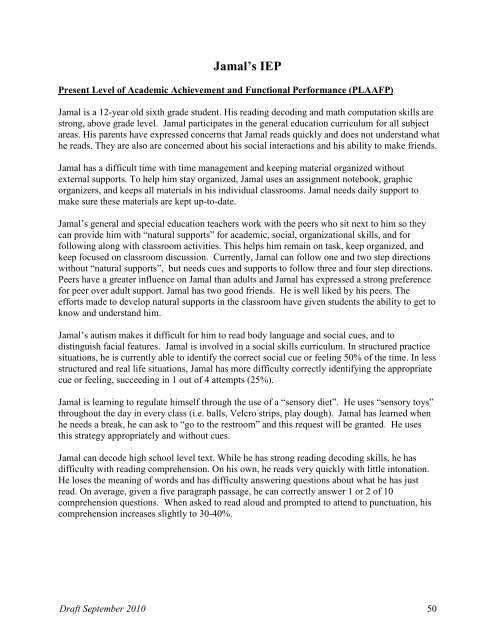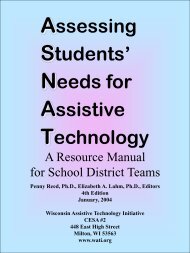Guide for Writing IEPs - The Special Education Team - Wisconsin.gov
Guide for Writing IEPs - The Special Education Team - Wisconsin.gov
Guide for Writing IEPs - The Special Education Team - Wisconsin.gov
You also want an ePaper? Increase the reach of your titles
YUMPU automatically turns print PDFs into web optimized ePapers that Google loves.
Jamal’s IEP<br />
Present Level of Academic Achievement and Functional Per<strong>for</strong>mance (PLAAFP)<br />
Jamal is a 12-year old sixth grade student. His reading decoding and math computation skills are<br />
strong, above grade level. Jamal participates in the general education curriculum <strong>for</strong> all subject<br />
areas. His parents have expressed concerns that Jamal reads quickly and does not understand what<br />
he reads. <strong>The</strong>y are also are concerned about his social interactions and his ability to make friends.<br />
Jamal has a difficult time with time management and keeping material organized without<br />
external supports. To help him stay organized, Jamal uses an assignment notebook, graphic<br />
organizers, and keeps all materials in his individual classrooms. Jamal needs daily support to<br />
make sure these materials are kept up-to-date.<br />
Jamal’s general and special education teachers work with the peers who sit next to him so they<br />
can provide him with “natural supports” <strong>for</strong> academic, social, organizational skills, and <strong>for</strong><br />
following along with classroom activities. This helps him remain on task, keep organized, and<br />
keep focused on classroom discussion. Currently, Jamal can follow one and two step directions<br />
without “natural supports”, but needs cues and supports to follow three and four step directions.<br />
Peers have a greater influence on Jamal than adults and Jamal has expressed a strong preference<br />
<strong>for</strong> peer over adult support. Jamal has two good friends. He is well liked by his peers. <strong>The</strong><br />
ef<strong>for</strong>ts made to develop natural supports in the classroom have given students the ability to get to<br />
know and understand him.<br />
Jamal’s autism makes it difficult <strong>for</strong> him to read body language and social cues, and to<br />
distinguish facial features. Jamal is involved in a social skills curriculum. In structured practice<br />
situations, he is currently able to identify the correct social cue or feeling 50% of the time. In less<br />
structured and real life situations, Jamal has more difficulty correctly identifying the appropriate<br />
cue or feeling, succeeding in 1 out of 4 attempts (25%).<br />
Jamal is learning to regulate himself through the use of a “sensory diet”. He uses “sensory toys”<br />
throughout the day in every class (i.e. balls, Velcro strips, play dough). Jamal has learned when<br />
he needs a break, he can ask to “go to the restroom” and this request will be granted. He uses<br />
this strategy appropriately and without cues.<br />
Jamal can decode high school level text. While he has strong reading decoding skills, he has<br />
difficulty with reading comprehension. On his own, he reads very quickly with little intonation.<br />
He loses the meaning of words and has difficulty answering questions about what he has just<br />
read. On average, given a five paragraph passage, he can correctly answer 1 or 2 of 10<br />
comprehension questions. When asked to read aloud and prompted to attend to punctuation, his<br />
comprehension increases slightly to 30-40%.<br />
Draft September 2010 50











